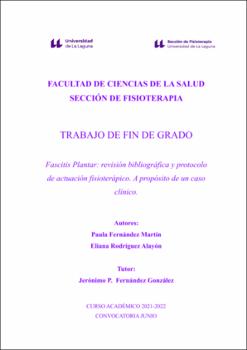Fascitis plantar: revisión bibliográfica y protocolo de actuación fisioterápico. A propósito de un caso clínico.
Fecha
2022Resumen
Introducción: La fascitis plantar (FP) es la inflamación de la fascia que recorre
desde la cabeza de los metatarsos hasta la zona plantar del calcáneo, es la afección
más habitual de dolor no traumático en el tobillo-pie en la población adulta y tiene
una prevalencia aproximada del 10%. Existe poco consenso en cuanto a tratamiento
se refiere, de la misma forma que no hay suficiente evidencia sobre la valoración
fisioterápica de dicha patología. Por ello vemos necesario elaborar un protocolo que
reúna las distintas técnicas a elegir.
Métodos: se realizó una revisión bibliográfica en las bases de datos
ScienceDirect, Cochrane Library, SciELO, Medline, Scopus, PEDro y en el motor de
búsqueda PubMed, en busca de los actuales abordajes fisioterápicos de valoración y
tratamiento de la FP.
Resultados: nuestra revisión bibliográfica consta de 7 artículos, que cumplieron
los criterios de inclusión establecidos.
Conclusión: la bibliografía actual es insuficiente y no se muestra un consenso
para su tratamiento además ninguno de los resultados abarca el campo de la
valoración. Se ha demostrado que la combinación de técnicas es más eficaz que el
empleo de una técnica aislada a modo de tratamiento. Por este motivo resulta
necesario la creación de un protocolo.
Protocolo Fisioterápico: con la información obtenida se ha elaborado un
protocolo de valoración y tratamiento fisioterápico que permitirá al fisioterapeuta
escoger distintas técnicas en función a la evolución de la patología.
Caso Clínico: se lleva a cabo la valoración propuesta en el protocolo . Introduction: Plantar fasciitis (PF) is the inflammation of the fascia that runs
from the head of the metatarsals to the plantar area of the calcaneus, is the most
common condition of nontraumatic pain in the ankle-foot in the adult population and
has a prevalence of approximately 10%. There is little consensus regarding
treatment, just as there is not enough evidence on the physiotherapy assessment of
this pathology. That is why we see the need to draw up a protocol that brings together
the different techniques to be chosen.
Methods: a bibliographic review was carried out in the ScienceDirect, Cochrane
Library, SciELO, Medline, Scopus, PEDro databases and in the PubMed search
engine, in search of the current physiotherapeutic approaches for the assessment and
treatment of PF.
Results: Our bibliographic review consists of 7 articles, which met the established
inclusion criteria.
Conclusion: the current literature is insufficient and there is no consensus for its
treatment and none of the results covers the field of evaluation. The combination of
techniques has been shown to be more effective than the use of an isolated technique
as a treatment. It is therefore necessary to create a protocol.
Physiotherapeutic Protocol: with the information obtained, a protocol of
evaluation and physiotherapeutic treatment has been developed that will allow the
physiotherapist to choose different techniques depending on the evolution of the
pathology.
Clinical case: the evaluation proposed in the protocol is carried out.





